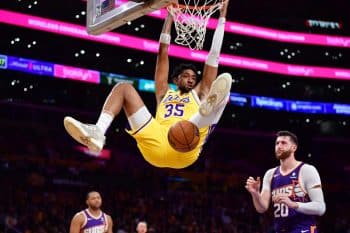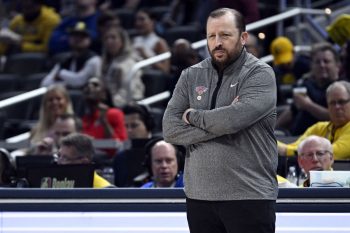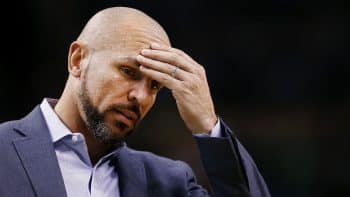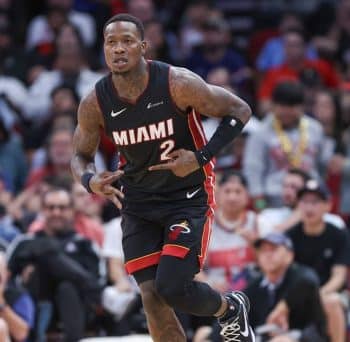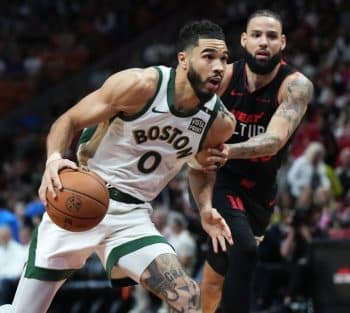NBA
NBA Daily: Wear & Tear Rearing Ugly Head In Playoffs

There is nothing worse in sports than seeing somebody get hurt.
In the NBA, we’ve seen plenty of devastating setbacks. Torn ACL’s, ruptured Achilles, broken bones—all of them season-enders and most of them career-alterers.
Jusuf Nurkic’s gruesome leg injury most recently comes to mind. Before that, Victor Oladipo and Dejounte Murray. Last year, Gordon Hayward’s season was cut short less than halfway into a single quarter, as was DeMarcus Cousins’ in the midst of a dominant campaign. And there’s more going without mention, to boot.
It’s unfortunate that these things happen. Most of them are freak accidents, bad luck or something completely unexpected in an instant. But there’s another type of injury that’s affected the league and its postseason that needs to be addressed.
The term “wear-and-tear” is used predominantly to describe the aging of inanimate objects—shoes, tires, furniture, you name it. Yet, it has another meaning when it comes to the human body. As is the case with the majority of athletes, NBA players like to push their limits, so much so that it sometimes ends up biting them in the behind from doing it on a consistent basis.
Not shortchanging the game on effort is to be expected, but giving 110 percent and going the extra mile nightly to earn victory after victory is a whole ‘nother level of commitment to your craft. While those guys should be rewarded for it, unfortunately, they are oftentimes unfairly punished.
There are three players in the current playoff picture who—when in tip-top shape—can change the course of their respective series in an instant. However, each of those respective talents is dealing with nagging pains affecting their games.
Drawing a first-round matchup with the Milwaukee Bucks wasn’t ideal for the Detroit Pistons. This writer picked an easy sweep for Giannis Antetokounmpo and friends. However, one would be remiss to say that Blake Griffin wouldn’t make things more interesting.
Based on Sunday night, it’s more than arguable that the Pistons wouldn’t have been even close to a .500 record without Griffin’s contributions. He made his first All-Star game in four seasons and played in his most total games in five years.
Of course, as the team battled for a playoff berth, he left every drop of sweat he had. It resulted in left knee discomfort, which has, in turn, caused him to reportedly miss the entire first round of the postseason.
That’s just one case in which a player isn’t seeing the floor. What about the ones who are trying to push through these moments with hefty minutes?
Dealing with a sore knee of his own, Joel Embiid decided to give it a go for the Philadelphia 76ers in their first-round opener. Though he dominated the paint in the early moments and still put up a 22-point, 15-rebound, five-block stat line, it was clear that the dynamic seven-foot center wasn’t himself.
Embiid fired off a third of his shot attempts from the perimeter and never found the mark. When he put the ball on the floor, the burst and nimble footwork he’s shown time after time wasn’t quite there. Sixers head coach Brett Brown could only keep him out there for 24 minutes, well below his season average.
Yes, an Embiid at 75 percent is better than one at zero. It’s just not the same monster we’re all used to seeing on that court, which sucks because, when healthy, “The Process“ is as entertaining and talented as it gets, regardless of size.
We can head out west to find another example. Paul George’s shoulder is clearly bothering him. He stated Monday that the pain is gone—even though there was a bag of ice wrapped around his upper right body as he said the words. That’s probably the right avenue to take so there’s no competitive advantage for the Portland Trail Blazers to exploit against the Oklahoma City Thunder.
George won’t admit this because he wants to be out there and compete at the highest level at the biggest stage. It’s admirable that he’s playing through the pain. He was out there for 42-plus minutes and gave his group all he had. Anybody would take 26 points, 10 rebounds and four steals as an impressive output, too.
It’s the rate at which George struggled—8-for-24 from the field and 4-for-15 from deep, a trend that’s been happening since the All-Star break. Decreased shooting percentages have seemed to be the byproduct of overdoing it. It’s a shame because PG had been lighting it up in the first half of the season to the tune of 40 percent as a three-point shooter.
Whether it’s the reps that have had a negative effect on his motion or the physical style he’s played on both ends, George hasn’t looked like the MVP candidate we were watching back in the December and January.
So why are we bringing this up? Let’s put it as straightforward as possible—shorten the season and start the playoffs earlier.
The topic came up at Adam Silver’s recent media availability session after meeting with the NBA’s Board of Governors, though it was mostly about the pressing concern with players over-resting rather than the subject of wear and tear.
The commissioner has already done an outstanding job at taking a once-ridiculously grueling schedule filled with back-to-backs & four days in five nights and removing the number of such instances at a rapid rate (and completely eliminating the latter).
Possible solutions to lessening the 82-game load are to get rid of preseason altogether and begin the year then. Silver surmised to reporters that in-season tournaments based on the model of soccer overseas might be a way to do it. Another idea brought to the table was taking the full game length from 48 minutes to 40 minutes.
Actively seeking to make the league better is what makes Silver so revered by the NBA, players and executives alike. He’s exceptionally aware of concerns and always has his ears open.
We deserve to see players perform at their peak, especially during this time of year. It’s impossible to control what happens on the floor, but it’s possible to determine the frequency at which things occur.
So, Mr. Silver, this writer is pleading with you: Follow through.
